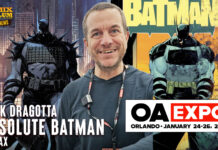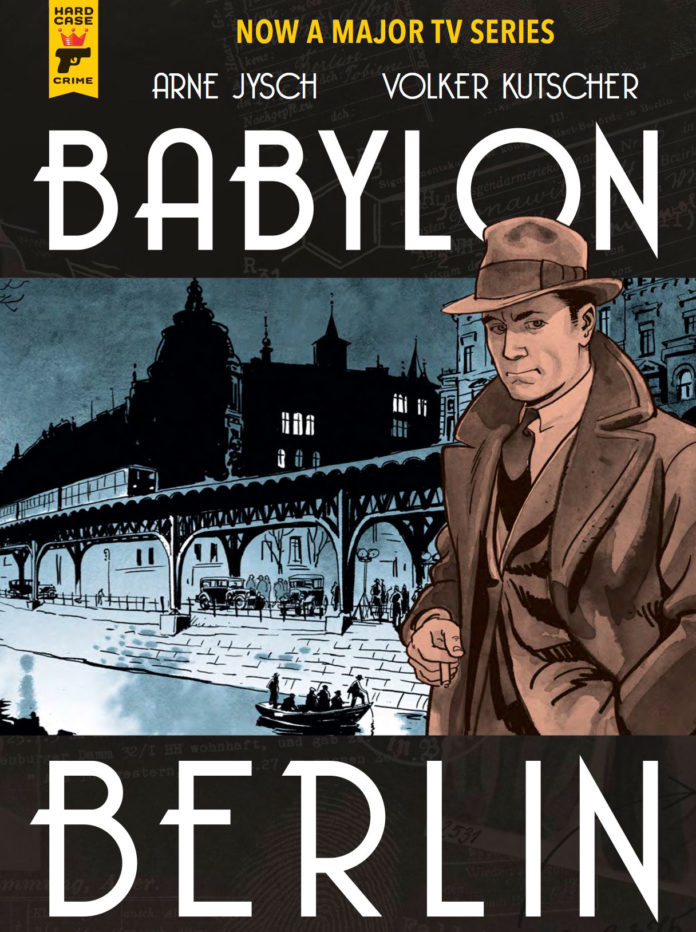Baylon Berlin is a new graphic novel from Titan Comics inspired by Volker Kutscher’s crime novel Der nasse Fisch and the Babylon Berlin TV series currently streaming on Netflix. I recently had the chance to touch base with Arne Jysch to get his thoughts on adapting the story into a graphic novel.
SB: Tell us about Babylon Berlin.
AJ: Babylon Berlin is the comic book adaptation of original crime novel Der nasse Fisch (The Wet Fish – a 1920s Police expression for “cold case”) written by Volker Kutscher, published in 2008. It follows thirty something maverick police detective Gereon Rath through the vibrant Berlin of the year 1929. While attempting to solve a murder case on his own to become part of the famous homicide division he gets more and more entangled between his lies, deceit, political unrest, sex, drugs and an underworld crime lord until he finally discovers who really is his worst enemy… The graphic novel – like the original – opens an atmospheric window to the short period in German history, when the political future was uncertain and the growing, pleasure loving middleclass wanted to live excessively. My goal was to throw the reader right in the middle of it, through the eyes of Gereon Rath he is able to witness not only the social, political tension and a twisted crime case but also gets a vivid impression of historical police work.
 SB: How much of your adaptation is faithful to the Netflix series or the original novel?
SB: How much of your adaptation is faithful to the Netflix series or the original novel?
AJ: My adaptation is much more faithful to the original novel than the TV series. It’s mostly because of format and medium. Where I had to transform a 500 page novel to a 200 page comic book and had to find the core, the essence of the story, the filmmakers extended the whole Idea, even created additional storylines and characters to fill 16 episodes.
I had to find the heart of the original and decided to show the story from the point of view of the protagonist. That resulted in one of the main alterations that I invented during the transformation: The first-person narrator. I wanted to keep as many of the iconic, impressive scenes from the novel, I wanted to hit the correct motivation, the soul of the characters. Of course, there are many differences to the novel, but only when I thought it would help to dramatize and shorten the visual narration. I think the connoisseur of the original novel will have as much fun with the comic book version as the one who doesn’t know the original. It’s interesting to compare the TV series to my adaptation and the changes we both did during the interpretation. There are quite a few similarities in the changes, which seem to be obvious when you transform Kutscher’s story to a visual medium.
SB: What I found interesting is even though Babylon Berlin is set in the 1920’s a lot of the themes are timeless and relevant today.
AJ: Sure, that’s already one of the fortunes of Kutscher’s original novel, that I not only embraced but emphasized whenever possible. I hope it’s not so much “on the nose” but more on a subliminal level. I avoided constantly reminding the reader of the present, because I wanted to achieve this time travel feel, but I like the ping-pong with the knowledge of the modern day reader.
Actually, when I was working on the clean up drawings I changed some of the dialogue while witnessing recent political developments in present Germany. Just a tiny little bit, but enough to make it feel more current.
 SB: Can you share your technique for adapting the novel into a graphic novel?
SB: Can you share your technique for adapting the novel into a graphic novel?
AJ: First I had a few talks with Volker Kutscher to get an impression about what he likes. The main task was to compress the novel to a much shorter graphic version. His only advice was: “Keep your favourite scenes and built your version around it”. So first, I did a list of all the scenes of the novel as an overview, it was all about what information do we get in what scene. And what tells us a certain moment between the characters.
Then I stripped it down to the skeleton of the plot. Really very low to what I thought is essentially necessary. Then I began to put back all the meat but on a much smaller scale with fewer parts. I think, it’s much better to not shorten it as a whole but instead get rid of some scenes and characters completely to make room for the important ones. It’s about: what plot-information from several different scenes can be combined into one? Is it better to change the order of some scenes here and there? This resulted in a written, dramatic page layout for the graphic novel, but without dialogues or details. Now came the fun part: I enriched it with some new visual Ideas and enhanced my favourite moments, before I finally started to draw the first storyboard version.
SB: It plays like a noir and films from the great black and white era of Hollywood. Did you ever think of adding colour to the adaptation?
AJ: Yes, initially Volker and I planned it as a coloured version. We thought it is quite a cliché that the past that we usually know from black and white photographs is actually presented in black and white. But after my hard experience with having to color 190 pages on a tight schedule for my previous book, the publisher and I decided to keep Babylon Berlin in black and white. It’s simply much less work and time. But it was fun to recreate a little bit of the atmosphere we get from seeing photographs, movies and Illustrations of the 1920s. The use of black shapes and grey watercolour wash is inspired by contemporary artists of that era. So I was able to get across that vintage feel not only by showing fashion, furniture and so on but by the drawing style as well. So finally, the economical black and white was turned into an artistic benefit.
 SB: The art is wonderful and really compliments the story. Did you draw any influence from German expressionism from the 1920’s?
SB: The art is wonderful and really compliments the story. Did you draw any influence from German expressionism from the 1920’s?
AJ: No, not really. Of course, you have that in mind when you are working on a Graphic Novel set in 1920s Germany, but the great time of German expressionistic movies was a bit earlier. And typical for them is the use of distorted perspectives and exaggerated acting. That wouldn’t have helped Babylon Berlin and it’s idea to depict the reality of the time. I did use some references to the lighting style of the 1920s and 30s movies but it’s not necessarily connected to expressionistic classics. The Fritz Lang movies M- eine Stadt sucht einen Mörder and Das Testament des Dr. Caligari are some inspirations to name.
Babylon Berlin from Titan Comics is on sale now and the TV show that inspired it is currently streaming on Netflix.
































